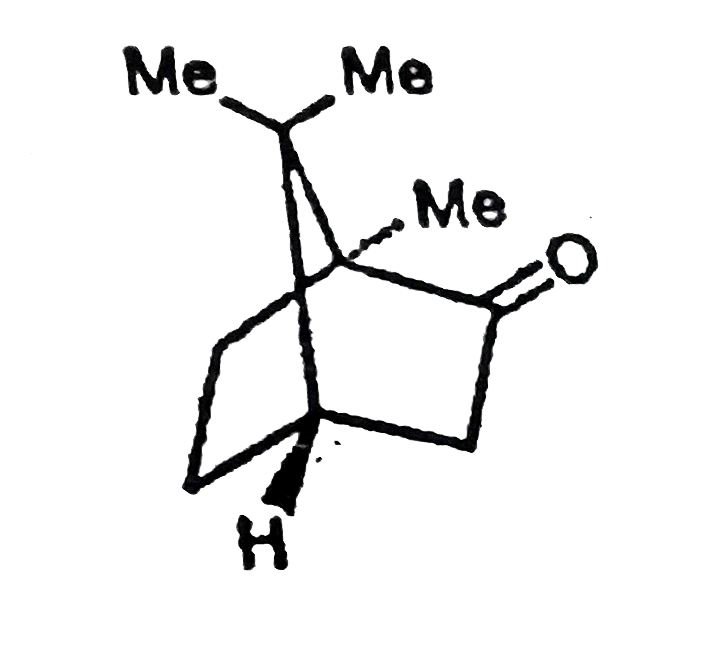n' number of alkenes yields 2,2,3,4,4- pentamethyl-pentane on catalytic hydrogenation and 'm' number of monochloro structural isomers are possible for this compound.report your answer as (n+m)
The correct Answer is:4
To solve the problem, we need to determine the values of 'n' (the number of alkenes that yield 2,2,3,4,4-pentamethylpentane upon hydrogenation) and 'm' (the number of monochloro structural isomers for this compound). Finally, we will report the answer as n+m.
1. Identify the Product Structure:
The product given is 2,2,3,4,4-pentamethylpentane. The structure can be drawn as follows:
- The main chain is a pentane (5 carbon atoms).
- The substituents (methyl groups) are located at positions 2, 2, 3, 4, and 4.
Structure:
CH3|CH3−C−CH−C−CH3|∣CH3CH3
2. Determine the Possible Alkenes (n):
Since the product is obtained through catalytic hydrogenation, we need to identify the possible positions for a double bond in the alkene that would yield this product upon hydrogenation.
- The double bond can only exist between the carbons where it does not violate the tetravalency of carbon.
- After analyzing the structure, we find that the double bond can be placed between:
- C2 and C3
- C3 and C4
- Hence, there are two possible alkenes that can yield the same product upon hydrogenation.
Therefore, \( n = 2 \).
3. Determine the Number of Monochloro Structural Isomers (m):
To find the number of monochloro structural isomers, we need to consider the different positions where a chlorine atom can replace a hydrogen atom in the structure.
- The structure has three types of hydrogen atoms:
- 3 equivalent hydrogens on C1
- 3 equivalent hydrogens on C2
- 3 equivalent hydrogens on C3
- 3 equivalent hydrogens on C4
- The unique positions for substitution are:
- Substituting on C1 (1 isomer)
- Substituting on C2 (1 isomer)
- Substituting on C3 (1 isomer)
- Substituting on C4 (1 isomer)
- Substituting on C5 is not unique since it is equivalent to substituting on C1.
Therefore, the total number of monochloro structural isomers is \( m = 4 \).
4. Calculate n + m:
Now, we can calculate \( n + m \):
\(
n + m = 2 + 4 = 6
\)
Final Answer:
The final answer is \( 6 \).
The product given is 2,2,3,4,4-pentamethylpentane. The structure can be drawn as follows:
- The main chain is a pentane (5 carbon atoms).
- The substituents (methyl groups) are located at positions 2, 2, 3, 4, and 4.
CH3|CH3−C−CH−C−CH3|∣CH3CH3
Since the product is obtained through catalytic hydrogenation, we need to identify the possible positions for a double bond in the alkene that would yield this product upon hydrogenation.
- After analyzing the structure, we find that the double bond can be placed between:
- C2 and C3
- C3 and C4
- Hence, there are two possible alkenes that can yield the same product upon hydrogenation.
To find the number of monochloro structural isomers, we need to consider the different positions where a chlorine atom can replace a hydrogen atom in the structure.
- 3 equivalent hydrogens on C1
- 3 equivalent hydrogens on C2
- 3 equivalent hydrogens on C3
- 3 equivalent hydrogens on C4
- The unique positions for substitution are:
- Substituting on C1 (1 isomer)
- Substituting on C2 (1 isomer)
- Substituting on C3 (1 isomer)
- Substituting on C4 (1 isomer)
- Substituting on C5 is not unique since it is equivalent to substituting on C1.
Now, we can calculate \( n + m \):
\(
n + m = 2 + 4 = 6
\)
The final answer is \( 6 \).
Topper's Solved these Questions
- BOOK - RESONANCE ENGLISHCHAPTER - STRUCTURAL IDENTIFICATION & PRACTICAL ORGANIC CHEMISTRYEXERCISE - Additional theory4videos
STRUCTURAL IDENTIFICATION & PRACTICAL ORGANIC CHEMISTRY
- BOOK - RESONANCE ENGLISHCHAPTER - STRUCTURAL IDENTIFICATION & PRACTICAL ORGANIC CHEMISTRYEXERCISE - Additional Exercise15videos
STRUCTURAL IDENTIFICATION & PRACTICAL ORGANIC CHEMISTRY
- BOOK - RESONANCE ENGLISHCHAPTER - STRUCTURAL IDENTIFICATION & PRACTICAL ORGANIC CHEMISTRYEXERCISE - APSP30videos
STRUCTURAL IDENTIFICATION & PRACTICAL ORGANIC CHEMISTRY
- BOOK - RESONANCE ENGLISHCHAPTER - SOLID STATEEXERCISE - Part- IV21videos
SOLID STATE
- BOOK - RESONANCE ENGLISHCHAPTER - THERMODYNAMIC & THERMOCHEMISTRYEXERCISE - INORGANIC CHEMISTRY(P-Block Elements)26videos
THERMODYNAMIC & THERMOCHEMISTRY
Similar Questions
'n' number of alkenes yield 2,2,3,4,4-pentamethyl-pentane on catalytic hydrogenation and 'm' number of monochloro structural isomers are possible for this compound.
Report your answer as (n+m).View SolutionHow many structural isomeric alkenes give 2,3− Dimethylpentane on catalytic hydrogenation
View SolutionThe number of structure isomers possible from the molecular formula C3H9N is:
View SolutionThe number of structure isomers possible from the molecular formula C3H9N is:
View SolutionCl−O bond order in perchlorate ion is M and number of
resonating structures are N, report your answer as (M×N)View SolutionThe total number of structural dihaloderivative possible in n-pentane are _____.
View SolutionFind the number of amine isomers which are structural isomers of the molecular formula C4H11N
View SolutionIf the number of Chiral carbon in camphor is X and total number of racemic form is Y then, report your answer is 4[X+Y]
 View Solution
View SolutionGive the total number of possible structural isomers of the compound II(Cu(NH3)4][IIPtCl4] .
View SolutionThe number of possible monochloro derivatives of 2,2,3,3-Tetramethylbutane is -
View Solution

